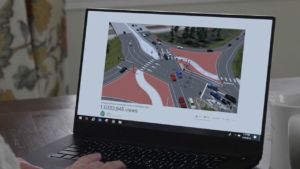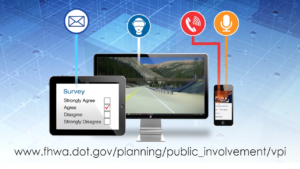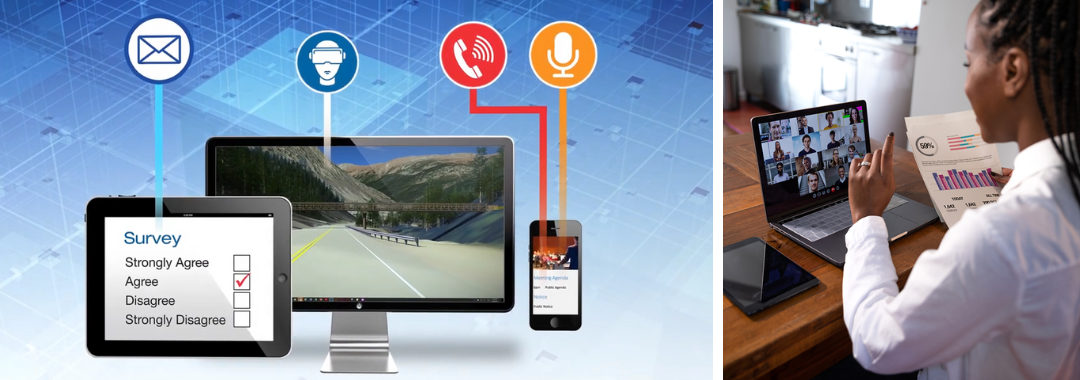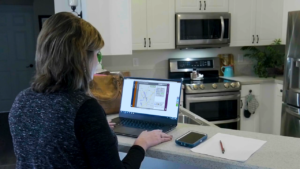Virtual Public Involvement presents an opportunity to expand the community engagement process. An FHWA Every Day Counts Round 6 initiative (EDC-6), Virtual Public Involvement (VPI) gives participants an opportunity to engage, other than through a traditional, physical meeting, which can require more time and resources to attend. The use of virtual engagement technologies can boost public participation in the comment process, and provide new avenues for collecting data and disseminating information on potential infrastructure investments and other projects. By increasing opportunities for public communication and engagement, VPI can serve to ensure that the needs of the public are fully considered in transportation project planning and development decisions.
At NJDOT, the COVID-19 pandemic presented new challenges and opportunities for the agency’s public engagement efforts. The necessity of social distancing motivated the Department to conduct meetings and outreach virtually, transforming the outreach process. To learn more about the lessons learned in making this transition, three NJDOT staff members were interviewed: Vanessa Holman, the Deputy Chief of Staff, serves as NJDOT’s legislative liaison and oversees the Department’s Office of Government and Community Relations; Megan Fackler, Director of the Office of Government and Community Relations (OCR), oversees public engagement and handles responses to DOT-related issues and concerns raised by the public, elected officials, and others; and Zenobia Fields, Senior Policy and Program Advisor, is responsible for policy related to planning and programming, including statewide plans and safety initiatives, and engaging with national organizations (AASHTO, TRB). Their observations are summarized below.
What was VPI like at NJDOT before the pandemic?
NJDOT has always strived to employ tools and mediums that will help achieve positive outcomes, working to ensure that the public is treated as valued customers.
Prior to the COVID-19 pandemic, the agency was not especially “tech-forward” with public engagement, and instead utilized more traditional, in-person engagement strategies. However, NJDOT staff who regularly engaged with stakeholders and attended external meetings were issued tablets to help facilitate in-person interactions. Staff had access to Microsoft Teams and preliminary training in using that platform. So, at the onset of the pandemic, the OCR and other staff were equipped with the technological capabilities to transition to virtual engagement.
How did the pandemic affect NJDOT’s public engagement efforts?
Beginning the third week of March 2020, NJDOT pivoted to a VPI style of engagement. With the assistance of IT staff, OCR held a large legislative summit for an NJDOT project, and began virtually conducting project-specific local official briefings, public information sessions, and public hearings. This outreach occurs during every phase of major projects from concept development through construction. Public Information Centers (PICs) are similar to an open house event, where the public is invited to attend and review at their own pace project drawings and plans, ask questions, and provide feedback. During the pandemic, NJDOT established project-specific PIC websites with multi-lingual content available. Links to certain PIC virtual meeting videos created by consultants were also made available for a certain period of time (e.g., 14 days), which has increased the number of persons accessing those meetings.
For certain projects, OCR sends hard copy letters to stakeholders who live within a certain distance to the project location informing them of the project and advising them to contact NJDOT if they need technical or other assistance to engage.
Several other units, such as traffic engineering, also began using virtual engagement technologies, including pre-construction meetings. The NJDOT Permitting unit has engaged applicants virtually to walk through documents, including technical project plans. Using the screen-share function, presenters can show and discuss complex technical materials, including maps and jurisdictional documents.
What platforms does the Department use?
NJDOT utilizes Microsoft Teams for most VPI for both internal and external outreach. The Department initially used Cisco WebEx and GoToMeeting, but determined that Microsoft Teams was the most optimal platform for internal meetings along with Cisco WebEx for public meetings. While the agency does not have a Zoom account, consultants often use Zoom for public and stakeholder engagement.
Consultants are encouraged to use a variety of online engagement tools for public and stakeholder feedback such as crowdsourcing, wiki maps, mobile apps, videos, etc. NJDOT has used crowdsourcing to identify potholes, locations for bike share stations and other information.
How has the Department implemented VPI as a practice?
VPI has been embraced at the Department, necessitated by the pandemic, however standardized VPI as an implemented practice is still a work-in-progress. Some staff have received training in VPI and attended webinars on the topic from AASHTO and FHWA through its EDC-6 program, but the training has not extended beyond these collaborations. The expansion of VPI training for staff could be valuable to embed best practices about what works, and what doesn’t.
What are some of the benefits that have come with implementing VPI?
Overall, stakeholder meetings have experienced higher attendance and participation, such as the Strategic Highway Safety Plan meetings, because people do not have to travel, and can also avoid parking, traffic, scheduling conflicts, etc.

VPI tools are being using by transportation agencies to enable the public to access user-friendly features to receive information and provide input.
Also, employing VPI for PICs has afforded participants with more time to access project information at a time that is convenient to them and to formulate thoughtful comments and questions on the specific project. VPI has also helped NJDOT to more formally capture and respond to comments and inquiries via electronic tracking, as compared to in-person comment collection. Many NJDOT project websites include a hyperlink to make accessing them easier for the public, enabling them to “click” on the link to access project-related information and provide feedback. And, interested parties can opt to receive text or email alerts from the Department on certain projects (e.g., Route 495 project e-alert; I-295 project).
An in-person open house event or PIC gives participants approximately three hours to review materials and provide feedback, however a virtual event can be made available for a longer period via a hyperlink. Attendees of a virtual event do not have to travel and wait in line to ask questions or to share comments, which can be very time consuming at a highly attended PIC; instead, they can post feedback on chat or via a Q&A function, or ask questions via telephone. Virtual engagement also enables participants to view documents and materials at their own pace, allowing them to return multiple times if needed over a period of days or weeks.
Over the past 18 months, implementing VPI has also become easier for NJDOT staff because their familiarity with VPI platforms and tools has increased. VPI makes certain tasks simpler as well. For example, while the services of a translator would need to be secured for an in-person event, translation is undertaken automatically with certain VPI platforms (e.g., Google translate).
What are some of the challenges of implementing VPI?
Learning how to successfully employ VPI has involved a great deal of trial and error. It was helpful to use consultant services for some of the Department’s initial VPI events. There are always challenges when implementing virtual mediums, with technology, security, and establishing best practices. For example, early in the pandemic, a Zoom “bomber” hacked into one of the Commissioner’s virtual meetings, which necessitated a temporary meeting shut-down. Other common technology challenges encountered included difficult connections for participants, and issues with microphone and camera functionality.

The FHWA maintains a VPI webpage that is a store-house of case studies, webinars and peer changes on model practices.
Another concern regards ensuring full participation, as attendance does not necessarily mean engagement. Participants are encouraged to turn on their video cameras to minimize their multi-tasking during VPI – something that is not really an obstacle during in-person meetings. Using break out rooms, chat and the “raising hand” online platform features have been helpful to encourage engagement. Online polls have also been a successful VPI tool including Zoom polls, Mentimeter, and Poll Everywhere to encourage engagement.
Some people are quiet and may not be as open on VPI as they would be when talking one-on-one with a person, so there needs to be a balance of VPI engagement and effort made to ensure all of these virtual conversations are happening as they would if they were convened in person.
Receiving state approval to secure licensing for new platforms can be a lengthy process due to security reasons, as can be securing departmental acceptance and adoption of new technologies. Moving forward, the Department is open to learning and trying new virtual platforms and technologies to achieve goals, but at this time there is not a specific VPI need not being met.
What equity concerns have you observed with VPI?
NJDOT remains compliant with federal civil rights and non-discrimination requirements, with a Public Involvement Plan, and the Civil Rights group and Title VI Liaisons involved in each project. An initial challenge at the start of the pandemic was ensuring NJDOT’s VPI complied with NEPA and Title VI regulations. The Civil Rights unit was very helpful in navigating these regulations and ensuring OCR performed their due diligence in this regard.
Another challenge was ensuring that NJDOT was engaging with all, including those who are underserved, under-represented and do not have access to virtual platforms. Projects must be compliant and also must ensure engagement opportunities are accessible and folks have the technology needed for virtual access (e.g., smartphone, landline) and that computers are not needed in order to participate.
It is important to review and measure how many are participating and the quality of feedback obtained. Some low-income or non-tech savvy members of the public may not have the technology or computer literacy to participate in VPI. In order to address this “digital divide,” focus has been given to expanding broadband connectivity options, such as creating mobile hotspots in areas close to project sites where residents without Wi-Fi or broadband might be able to connect to the internet, making NJDOT interactive tablets available, and connecting through their smartphone or landlines to enable folks to meaningfully participate in the engagement process. If access to any technology is still a barrier for participation, another solution is to provide the opportunity to simply place hand-written suggestions in a physical comment box placed within the geographic limits of the particular project so it is easily accessible to local stakeholders.
What best practices have been developed with VPI?
A key best practice for staff working with VPI is to prepare a script and talking points ahead of time, and to practice with the team prior to the event to ensure familiarity and troubleshoot any identified technological issues. This pre-event planning process helps to ensure a smooth flow during the meeting.
Based on our COVID-19 experiences of the past eighteen months, NJDOT has learned more about the pros and cons of various platforms depending on the target audience, meeting topics, and goals. For example, MS-Teams has been best for internal meetings, or small meetings with elected and local officials, while Zoom’s webinar platform has been ideal for larger meetings and broader, more active public engagement. The use of a consultant to moderate public engagement has been beneficial, such as with enforcing time limits during comment sessions and assisting with technology issues. Over time, implementing VPI has become easier as familiarity with the platforms and technologies has increased among both NJDOT staff and the public.
How does the Department use social media in the public involvement process?

NJDOT has been using Facebook and Twitter, as well as YouTube to communicate longer video content. The Department uses social media to alert members of the public about upcoming PICs.
The primary social media platforms NJDOT uses are Facebook and Twitter, as well as YouTube to communicate longer video content. The Department uses social media to alert members of the public about upcoming PICs, offering the link to virtual PICs via Facebook posts. Facebook has been helpful for event pre-planning, and Twitter and the 511 website – a traffic condition platform – are effective when there is an immediate need to communicate to the public. The public uses social media to post comments and inquiries. Typically, the public feedback communicated through social media is brief, but sometimes commenters provide thoughtful, in-depth remarks from which NJDOT’s OCR can respond.
The Department also uses social media and other outreach tools to inform the public about NJDOT services and role in the community, emphasizing its customer focus. For example, the NJDOT Commissioner drafts an external e-newsletter called “Commitment to Communities” or C2C, that is distributed four-six times annually. Often the content focuses on “Did you know” types of facts related to NJDOT’s role and services. Approximately 6,000 persons subscribe to the newsletter. The online Local Aid Resource Center also uses various social media platforms to communicate primarily to existing and interested grantees.
NJDOT’s social media policy was established prior to the current administration, and primarily focused on employee practices and appropriate behavior as representatives of the Department. NJDOT is working on developing a new social media policy that will address how to monitor and manage the Department’s social media accounts, including how comments should be responded to and handled. The Department has recently hired a social media coordinator, as well as an in-house videographer. The social media coordinator has increased the Department’s Facebook following to 11,000 persons, which is a significant achievement, especially because the Department does not have an advertising budget for social media. The Department is considering trying new social media platforms, such as Instagram, and continually engages with other state department social media coordinators to learn from their work.
How will VPI be used moving forward?
Overall, both the quantity and quality of NJDOT public engagement increased with VPI implementation during the pandemic and VPI will continue post pandemic. Moving forward, the Department is open to learning and trying new virtual platforms and technologies to achieve goals, which will continue to be evaluated.
While VPI is more economical, in-person engagement remains relevant. NJDOT plans to utilize a hybrid engagement approach, with a mix of VPI and face-to-face engagement. Additionally, the Department must continue to work with community partners as trusted advocates to attract and encourage participation from a diverse set of constituents. The Department will further explore the expanded use of crowdsourcing tools, and the development of an online application for the public to use to contact NJDOT, in addition to using the Department’s central dispatch number.
Resources
FHWA. Virtual Public Involvement. Retrieved from: https://www.fhwa.dot.gov/innovation/everydaycounts/edc_6/virtual_public_involvement.cfm
NJDOT. Technology Transfer Online Training Library, Virtual Public Involvement Peer Exchanges and Video Case Studies Online. Retrieved from: https://www.njdottechtransfer.net/2021/08/06/vpi-peer-exchanges-video-case-studies/


